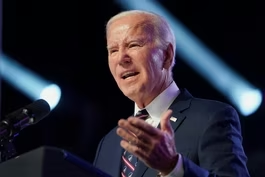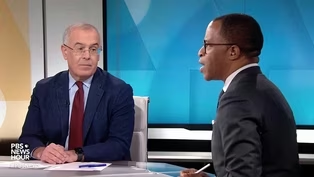
Stars of new musical discuss connecting with autistic adults
Clip: 1/5/2024 | 7m 54sVideo has Closed Captions
The stars of 'How to Dance in Ohio' on exploring connections among autistic adults
A new musical recently debuted on Broadway that puts the stories of seven autistic young adults front and center as they face the challenges of leading independent lives. Jeffrey Brown talks to the creators behind "How to Dance in Ohio" and some of its stars for our arts and culture series, CANVAS.
Problems playing video? | Closed Captioning Feedback
Problems playing video? | Closed Captioning Feedback
Major corporate funding for the PBS News Hour is provided by BDO, BNSF, Consumer Cellular, American Cruise Lines, and Raymond James. Funding for the PBS NewsHour Weekend is provided by...

Stars of new musical discuss connecting with autistic adults
Clip: 1/5/2024 | 7m 54sVideo has Closed Captions
A new musical recently debuted on Broadway that puts the stories of seven autistic young adults front and center as they face the challenges of leading independent lives. Jeffrey Brown talks to the creators behind "How to Dance in Ohio" and some of its stars for our arts and culture series, CANVAS.
Problems playing video? | Closed Captioning Feedback
How to Watch PBS News Hour
PBS News Hour is available to stream on pbs.org and the free PBS App, available on iPhone, Apple TV, Android TV, Android smartphones, Amazon Fire TV, Amazon Fire Tablet, Roku, Samsung Smart TV, and Vizio.
Providing Support for PBS.org
Learn Moreabout PBS online sponsorshipautistic young adults front and center as they# face the challenges of leading independent lives.
Adapted from a documentary, Jeffrey# Brown talks to the creators behind## the musical and some of its stars.
It's# for our arts and culture series, Canvas.
(CHEERING AND APPLAUSE) ACTOR: Welcome!
We are going to do a show for you.
JEFFREY BROWN: It's a musical# with an unusual opening,## in which the cast members introduce themselves.
ACTOR: The show is based on things# that actually ha have been embellished for dramatic purposes.
JEFFREY BROWN: Seven autistic# actors playing s characters with a message about their community.
ACTOR: There is the saying, if# you have met one autistic you have met one autistic person.
You# are now meeting seven autistic people.
(CHEERING AND APPLAUSE) with the audience at first and just# be IMANI RUSSELL, Actor: We're also# establishing that this is a place## where neurodivergence is welcome and accepted.
JEFFREY BROWN: Twenty-year-old Madison# Kopec and 27-year-old Imani Russell,## both with autism, are two of the# stars of "How to Dance in Ohio."
IMANI RUSSELL: The experience of being autistic# is so different from person to person.
And you## see that in the show and people connect with that# in the audience.
But it is really impor understand that, like, whatever ideas that# people might have going into the show about## what it means to be autistic, we're here to# be like, that's one idea.
That's one example.
ACTOR: When I'm out, I don't talk much.# I have trouble making facial expressions.## It's not that I don't care about what# you're saying.
Sometimes, I don't.
(LAUGHTER) making social connections, especially as they# strive to be more independent as young adults.
Madison Kopec, who was diagnosed with# autism at age 17, portrays Marideth,## who often turns to facts to avoid emotions# and potentially disturbing personal contact.
This focus on social interaction# and the difficulties of that... MADISON KOPEC: Yes.
MADISON KOPEC: Yes, I'm very familiar# wish I could be like Marideth sometimes, where# she just kind of says, no thanks and leaves.
And I do, to a point.
But, also, I think# the journey she goes on is really important,## because she tends to, like, block# herself out from having any sort of,## like, interactions because she's afraid.
DOCUMENTARY PARTICIPANT: A lot of times,## people can't rea JEFFREY BROWN: The characters and story# are based on a 2015 HBO documentary of## the same name by director Alexandra Shiva, which# captured a real-life counseling clinic for teens## and young adults with autism in Columbus, Ohio,# as they prepared to hold a spring formal dance.
For composer Jacob Yandura, himself from# Ohio and with a younger sibling with autism,## turning it into a musical was deeply personal.
JACOB YANDURA, Composer: My sister Maria has been# a part of this for she was the first person I told about, like,# there's this documentary.
I mu sical.
And we watched it together, because it# was right around when I was home f And we immediately cried.
And she was like:# "Jacob, now the world can understand what## it's like to be me," you know?
That's what# I hope.
And it's the most -- it's been the# most beautiful gift, the show.
And I'm# getting emotional thinking about it.
JEFFREY BROWN: When she said that, you# thought, I have got to make this musical.
JACOB YANDURA: I have to make# this.
Yes, I have to make this.
JEFFREY BROWN: For director Sammi Cannold,## who also has an autistic sibl and some members of the larger# team meant adjusting her role.
SAMMI CANNOLD, Director: The main piece# of feedback in terms of direction that I## got from mostly our artistic performers# was that what they wanted from very clear and very specific direction,# not can you go over there by the door?## Can you go to eight and turn left and# then go to 10?
So very, very specific.
And that... SAMMI CANNOLD: The script, yes.
And I think that absolut and preparation that I'm thrilled to do, because# it allows our performers to do their best work.
JEFFREY BROWN: In fact, the two actors told us## that acting and following a scri and many autistic people get through# even the most routine interactions.
IMANI RUSSELL: Even, like,# with friends being like, OK,## I got to practice what I'm going# to say.
I'm going to mak little script before I go hang out with# pe MADISON KOPEC: People would always ask, how# can you perform in front of this huge crowd## of people and then be scared to perform in# front of three family member JEFFREY BROWN: Or even go to the store or... (CROSSTALK) MADISON KO JEFFREY BROWN: Yes, and kn MADISON KOPEC: Because I k mostly.
I know this character that I'm# playing.
And even when to a little bit of improv, which I have gotten# more comfortable with over the years, like,## I have still got this character.
So I have a basis# for how she would react in certai IMANI RUSSELL: And it's not like we don't## know h MADISON KOPEC: Right.
MADISON KOPEC: Yes.
theater brings us joy.
I don't like going# to the store.
It doesn't bring me any j (LAUGHTER) MADISON KOPEC: That's true, yes.
JEFFREY BROWN: For this show, accommodations a of aids and cool-down spaces for those who# need to step away due to sensory sensitivities.
Imani Russell hopes "How to Dance in Ohio"# not only helps people in the autistic## community feel represented, but also fuels# change in theater inclusivity more broadly.
IMANI RUSSELL: We're really doing something# that is connecting with people who are coming## and being like, I have never thought that I# could do this.
And seeing the seve stage is giving me hope that I can do this, that# theater, which already feels like a home to a lot of autistic people, but that they can actually do# it, which feels really, really important to me.
JEFFREY BROWN: In that sense,# says director Sammi Cannold,## this is entertainment-plus,# also a form of advocacy.
SAMMI CANNOLD: What's important is that I# think, when people hear the word advocacy,## they think maybe people# picketing on the street or,## like, someone lecturing at you# about what you should care about.
And I think that what I love about art# like this is that, if you come into it## off the street and you know nothing about it,# you're probably not going to leave and say,## I just saw advocacy, right?
But you are# going to leave with a better understand of a community that you may not have# had an understanding of before.
Or,## if you are a member of that community, you may# leave feeling JACOB YANDURA: Represented.
For the "PBS NewsHour," I'm# Jeffrey Brown in New York.
AMNA NAWAZ: Great to see those# stories on a big, joy-filled stage.
Biden warns political violence poses threat to democracy
Video has Closed Captions
Clip: 1/5/2024 | 7m 11s | Marking Jan. 6 anniversary, Biden warns political violence poses grave threat to democracy (7m 11s)
Brooks and Capehart on court deciding Trump ballot case
Video has Closed Captions
Clip: 1/5/2024 | 11m 37s | Brooks and Capehart on Supreme Court deciding if Trump can remain on ballots (11m 37s)
Can Florida's plan to import drugs from Canada lower costs?
Video has Closed Captions
Clip: 1/5/2024 | 6m 11s | Can Florida's plan to import drugs from Canada lower medication costs? (6m 11s)
Louisiana drought threatens to create a crawfish shortage
Video has Closed Captions
Clip: 1/5/2024 | 4m 19s | Extreme drought in Louisiana threatens to create a crawfish shortage (4m 19s)
Supreme Court to decide if Trump can be kept off ballot
Video has Closed Captions
Clip: 1/5/2024 | 5m 35s | Supreme Court to hear Trump ballot case that could upend 2024 presidential election (5m 35s)
What Wayne LaPierre's resignation means for the NRA's future
Video has Closed Captions
Clip: 1/5/2024 | 4m 56s | What the resignation of Wayne LaPierre means for the future of the NRA (4m 56s)
Providing Support for PBS.org
Learn Moreabout PBS online sponsorship
- News and Public Affairs

FRONTLINE is investigative journalism that questions, explains and changes our world.

- News and Public Affairs

Amanpour and Company features conversations with leaders and decision makers.












Support for PBS provided by:
Major corporate funding for the PBS News Hour is provided by BDO, BNSF, Consumer Cellular, American Cruise Lines, and Raymond James. Funding for the PBS NewsHour Weekend is provided by...





